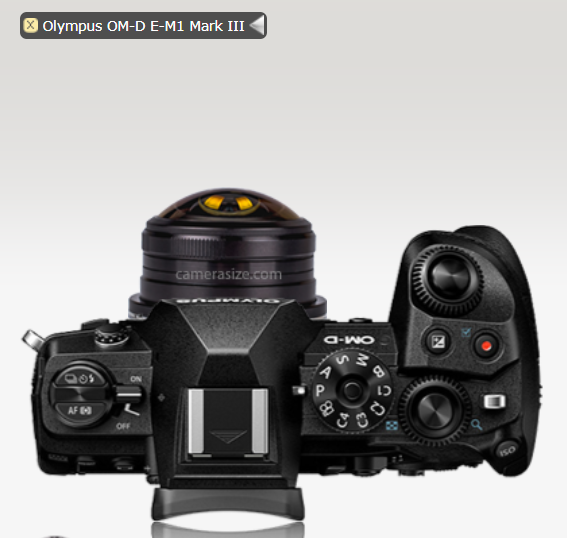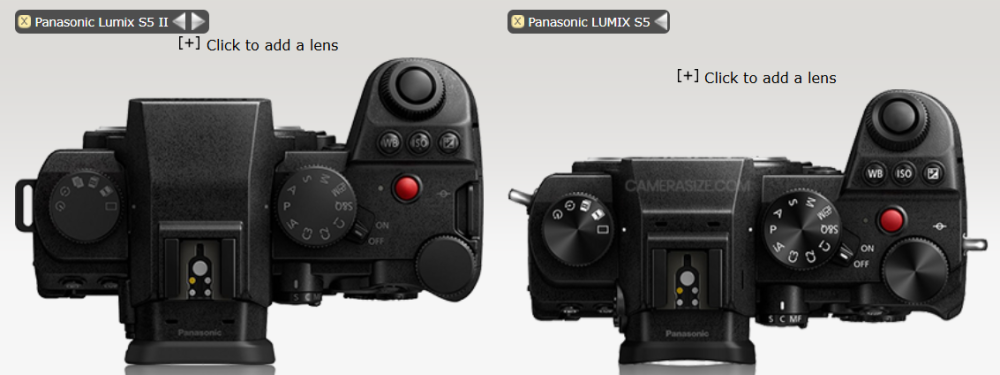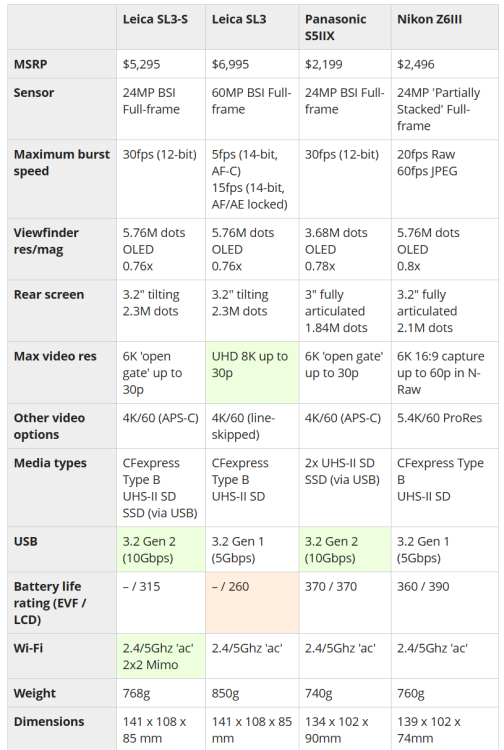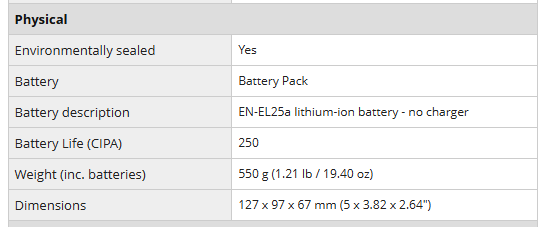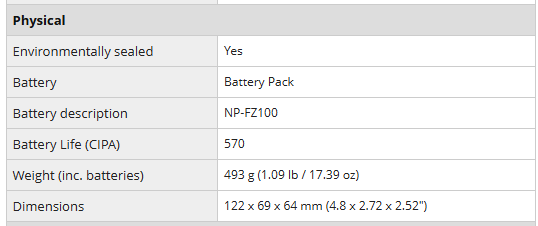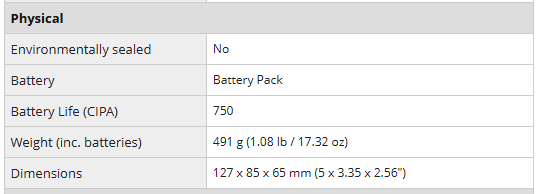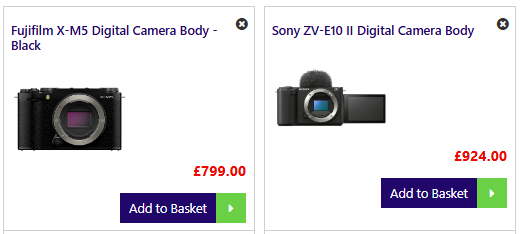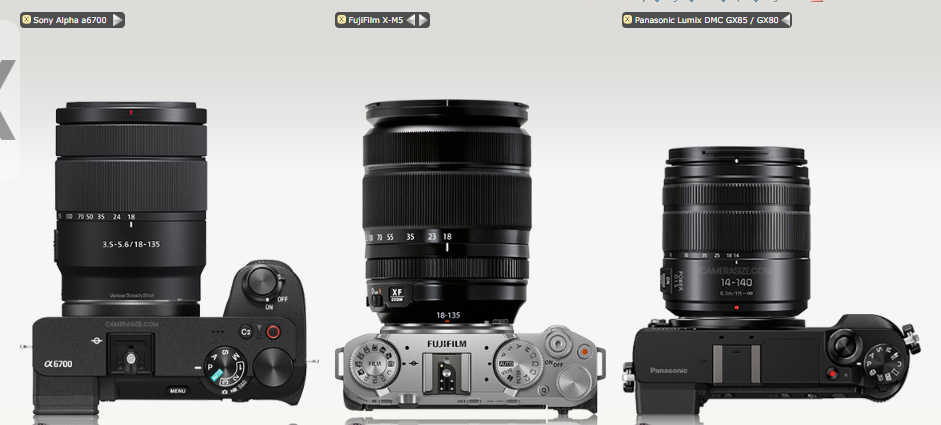
ac6000cw
Members-
Posts
640 -
Joined
-
Last visited
Content Type
Profiles
Forums
Articles
Everything posted by ac6000cw
-
I don't think they'd kill MFT completely while the GH7 and G9ii are still profitable, if only to get get a decent return on the investment in the 25MP sensor development. If they wanted to do an APS-C camera, the obvious one to me would be an 'S90' with a (top left corner) high-res EVF i.e. a direct competitor to the A6700 and X-S20. I agree, and have seriously thought about buying one plus the Sigma 18-50mm for that reason (I'm a '50p' video person and 4k50 is an enforced APS-C crop anyway). But then the A6700 has a much wider range of lenses available and an EVF... (Fuji cameras are ruled out for me as they don't support plug-in power for external mics).
-
I think that if Panasonic had wanted to just kill off the entire camera division, they'd probably have done it a few years ago, before committing to development and production of the S5 and GH6. They've culled the product range presumably down to what is (or is projected to be) profitable (which in the UK seems to be basically the FF S5D, S5ii/iix, S9, the MFT GH7, G9ii, GH5ii, G97, G100D, the superzoom FZ2000, FZ82 and the compact TZ99). So a few cameras in each sensor size. From what I've read occasionally, the lower-end Panasonic TVs have been more-or-less badge-engineered products from one or more of the big low-cost manufacturers for some time. So it wouldn't surprise me if they basically licensed the brand name (for TVs) to one of those and stopped in-house TV development and production.
-
Which is basically what they did with the E-M5 iii (but with the body re-designed to use plastics to reduce the weight - it's 20% lighter).
-
An MFT sensor is 17.3mm wide, an APS-C sensor is 23.6mm (see https://en.wikipedia.org/wiki/Image_sensor_format#Table_of_sensor_formats_and_sizes ). So the theoretical angle-of-view for the 7-Artisans lens on MFT is: 225 degrees * (17.3/23.6) = 165 degrees. Based on your 'finger test' photo, that is about right i.e. it looks like and calculates to be less than 180 degrees. The maximum depth/projection of the grip from the camera front on my E-M1 iii is a bit less than 30mm (AFAIK it is the same body shape and dimensions as the E-M1 ii).
-
It looks like the 7-Artisans lens is spec'd as an APS-C lens, so the field of view will be less on the smaller MFT sensor. If it helps, this is the Laowa 4mm 2.8 fisheye on an E-M1 iii:
-
The flange to sensor distance for L-mount is 20mm, for MFT it's 19.25mm, so a simple adaptor is not possible - L-mount flange to sensor distance would need to be at least a few mm less than MFT for that to work. Also, MFT is a 2x crop vs. FF, so with an MFT lens the 24MP S1/S1H/S5/S9 sensor would become a 6MP sensor (max resolution of 3000 x 2000 pixels). That's not enough for UHD video or decent resolution stills, so not a very attractive prospect. Nikon Z-mount is only 16mm flange to sensor distance (the shortest of the common mounts), hence other mirrorless lenses can theoretically be adapted to it e.g. the already existing E-mount to Z-mount adaptors. (See https://en.wikipedia.org/wiki/Flange_focal_distance for flange to sensor distance list).
-
Increasing interest in compacts, something is strange
ac6000cw replied to Andrew Reid's topic in Cameras
I agree the RX100/ZV-1 are pretty small (literally 'fit in the palm of your hand' cameras), but I think the ZV-1 combination of very small size, zoom lens, decent on-board sound (with an included wind muff!), mic jack, hot shoe and decent video/stills capability is hard to beat without going up significantly in camera size/weight/cost. The ZV-E10ii and X-M5 with their respective power-zoom kit lenses are probably the obvious 'upgrade' candidates. -
Increasing interest in compacts, something is strange
ac6000cw replied to Andrew Reid's topic in Cameras
As an alternative to an RX100 V, the ZV-1 is about the same size and weight - you loose the pop-up EVF, but gain an articulated LCD, a mic jack and a small grip on the front. It's also significantly cheaper than the RX100. The LX100 is quite noticeably larger than the RX100/ZV-1 (I used to own one), and is more jacket than trouser/pants pocket sized. The S9 feels much chunkier and heavier - even more so with the Smallrig grip attached - than the LX100 (based on playing with an S9 with/without grip in a camera store). -
-
...but by modern mirrorless standards it's quite a large and heavy body (from the left A7CR, A7R V, S5ii, S1R). The 1kg S1R is also about twice the weight of the A7CR. That limits the sales appeal of the S1x bodies to people who are prepared to live with the size and weight (and probably hands potential sales to Sony instead, hence Panasonic putting the S5 into a smaller, lighter body).
-
Not a 'flagship', just a decent value 60MP full-frame camera - I think that's the Lumix-brand market area now (with the possible exception of micro43, which is a niche anyway). The high-end of the partnership is Leica-branded... I'm sure Panasonic could design & build a camera with high-end build and feel, but I don't think they have the brand heritage to sell them at high enough prices. For example, the latest Leica version of the LX100 was launched last year, but no sign of a Lumix version so far...
-
Personally, I think they'll release a 60MP camera, probably in an S5ii body and priced somewhere between the A7CR and A7R V, obviously using much the same internals as the SL3. As for an S1H successor - I wouldn't like to bet either way, with Nikon being pretty aggressive on pricing across the Z-range and Canon offering 8K60p on the R5 ii. Where would Panasonic position it in the market, with the S5iix already offering more video features than most people need or use at a sub-$2000 price, and maybe not having access to the high-end Sony sensors Nikon are using in the Z6 iii/Z8/Z9 (or at least not a price that would make sense commercially). Plus of course they have a video-orientated 'flagship' camera in the guise of the GH7...
-
Being realistic, any S1H successor has to at least match and preferably exceed the basic video specs of the Z6 iii e.g. full-frame UHD/6k video up to 60p with sub-10ms rolling shutter, otherwise there's no point (and even fewer sales)... This means a new (to Panasonic) sensor - the old 24MP sensor just won't cut it in that market any more.
-
Yes. Worse battery life (based on CIPA ratings) plus a bit larger and heavier.
-
SL3-s has arrived - https://www.dpreview.com/reviews/leica-sl3-s-initial-review Spec comparison table from the article - it's seems basically an S5iix in a Leica body (at 2.5x the price).
-
I think the E-M1 iii has most of what the E-M1X has (except the AF subject detect and the extra battery) in a smaller package (the used prices are similar, with the E-M1 iii being a bit higher). They are mostly sub-1000 GBP in the UK (and the latest v1.7 FW update improved the subject-detect AF performance quite noticeably). At that price it's a lot of camera for the money. I agree (and the official OMLog400 to Rec709 LUT seems to produce some weird colours - the reds in particular). In case they might be useful to someone using an OM-1, these are some 10-bit BT2020 OMLog400 to Rec709 LUTs (in nine combinations of colour tint and contrast curve) I've made for my own use: https://drive.google.com/open?id=1-HBUDlPN0C3pQRX5c9Trmh8I3aM9hbiz&usp=drive_fs I use Vegas Pro for editing (and generating the LUTs) - so no idea how well the LUTs might work in Resolve etc. (and I rarely shot video where people are the main subject, so skin tone accuracy generally isn't important to me) (...and a big thank you to @Attila Bakos for the great free LUT tools on his Colorizer website )
-
Exactly. When I overhear people trying out/discussing/buying cameras in stores and at local camera shows, my impression is that taking still photos is the most important reason for buying a camera. Video hardly gets mentioned - it's a secondary 'nice to have, just in case' feature, not the main reason for buying what is perceived as a 'stills' camera (mostly because MILCs still look like traditional 35mm film cameras, I guess). What sells reasonably well for camera manufacturers is probably quite different to what interests people on this video-orientated forum (I know that's the case for me).
-
Yes, 10-bit 'Natural' would be really nice to have (and sharpness adjustment in 10-bit).
-
The 4k60p is not as detailed as 4k24/25/30p - see https://www.dpreview.com/reviews/image-comparison/fullscreen?attr29_0=omsystem_om1&attr29_1=omsystem_om1&attr72_0=4k_60&attr72_1=4k&attr421_0=10&attr421_1=10&normalization=full&widget=850&x=-0.3659681831889651&y=-0.46405799840375833 10-bit UHD or C4K at 24/25/30p are the most detailed modes. 50/60p is noticeably softer/less detailed. 10-bit also uses the (better) HEVC/H265 codec. The Sandisk Extreme (non-Pro version) is also fine for 4k60p in my experience.
-
Is suspect the reasons for leaving out IBIS (other than the Mk 1 didn't have it) are cost and weight e.g. the Sony ZV-10 ii doesn't have it either. But it's still larger and heavier than the A6700 and X-S20 (which have IBIS), and has the worst battery life out of the three. Nikon seem to be targeting the ZV-10 ii & X-M5 market price area but with the EVF as added value (in exchange for heavily cropped 4k60p, a larger & heavier body and less extensive moderately priced lens choices). Prices from Wex in the UK: Size/weight/battery life spec extracts from dpreview.com: Z50 ii: A6700: X-S20:
-
...which means it's using a smaller area than a M43 sensor when capturing 4k60p (1.5 x 1.5 = 2.25 crop relative to FF). If you enable EIS (it has no IBIS) that adds an additional crop.
-
It's not my main camera - that's currently an OM-1. I've kept the GX85 for use as a travel-cam, fitted with the 14-140mm lens - that combo is smaller and lighter than some smaller sensor 'superzoom' cameras. Its main downside (for me) is the poor quality audio (and no mic jack to work around that). The cropped 4k video isn't ideal either, but at least it's less cropped than the later 20MP sensor GX9 or G100. So (like you) it's my "when size & weight is more important than image and sound quality" M43 camera. AFAIK the only *reasonably small* hybrid M43 20MP cameras with uncropped 4K are the Oly E-M10 iv & E-M5 iii and the OMDS OM-5 (and they are all taller than the GX85/GX9, and only the E-M5 iii and OM-5 have mic inputs). I've thought about replacing the GX85 with an E-M5 iii or OM-5, but I already also own an E-M1 iii (the OM-5 is based on it internally) which is a bit larger and 170g heavier but is 'free' to me. I think what both of us would really, really like the G9 ii/GH7 sensor and processing in a smaller body...
-
If you need the superzoom lens, the combo of A6700 + Sony 18-135mm is actually a bit lighter (and is a slimmer lens) than X-M5 + Fuji 13-135mm, plus it has an EVF. (Assuming https://camerasize.com/ sizes and weights are accurate). But the Pana 14-140mm is much lighter and smaller than either the Sony or Fuji lens, and has wider zoom range... it's really hard to beat as a 'do almost anything' travel lens. I've been doing these kind of comparisons myself recently, with a view to possibly buying a *small* MILC with better video support than the GX85 I already own (and one that has a mic input). Comparison - https://camerasize.com/compact/#910.702,935.426,673.931,ha,t
-
As a G9 owner, note 4k50p/60p recording time is limited to 10 minutes. It's 30 minutes for everything else. G9 is a later design camera than the GH5 with better IBIS and AF (it's also bit larger than the GH5). It can't be powered over USB, but 3rd party dummy battery power adaptors are cheap. IMHO the (oversampled) 1080 50p quality isn't that far behind 4k50p in real world usage (and it can record it in 150Mbps 10-bit 4:2:2), if you need more than 10 minutes continuous recording. The more recent GH5 ii basically combines the best bits of the GH5 and G9. As for the 'long compact zoom', the Pana 14-140mm F3.5-F5.6 is an excellent small and light 'superzoom' if you don't mind the variable aperture. Probably my all round favourite M43 lens. The 'much brighter at the long end' 35-100mm F2.8 is also fairly compact, but has more focus breathing.
-
Panasonic has added a new S9 firmware update 1.2 to replace the withdrawn FW 1.1:


